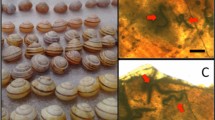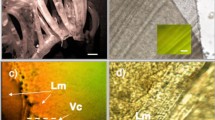Abstract
THE chitinous integument of many invertebrates consists not of chitin alone but also incorporates much structural protein. In the more highly sclerotinized arthropod shells, indeed, this may far exceed the true chitin. The methods frequently used for softening ‘chitin’ for histological purposes make use of this fact, and none of them actually alters the chitin itself, acting instead on the protein moiety of the integument. ‘Diaphanol’, for example, the most widely used agent for softening ‘chitin’, acts by breaking benzene rings in the aromatic amino-acid residues of the proteins1. Inevitably such an action is accompanied by extensive damage to the tissues of the specimen, for not only is the protein of the skeleton idigested but also the proteins of the tissues which we wish to examine. The use of diaphanol, or of other agents which digest the protein moiety of the chitinous integument, is therefore incompatible with precise histological or cytological investigation. If the integument consists mainly of structural protein, then we have no way out of the dilemma except to dissect the tissues free from all traces of the offending shell. If, however, as in the less-sclerotinized shells, it consists chiefly of true chitin, then it is possible to attack the chitin enzymically, leaving the tissues untouched.
This is a preview of subscription content, access via your institution
Access options
Subscribe to this journal
Receive 51 print issues and online access
$199.00 per year
only $3.90 per issue
Buy this article
- Purchase on Springer Link
- Instant access to full article PDF
Prices may be subject to local taxes which are calculated during checkout
Similar content being viewed by others
References
Kennaugh, J., Nature, 180, 238 (1957).
Tracey, M. V., in Paech, K., and Tracey, M. V., “Modern Methods of Plant Analysis”, 2 (Springer-Verlag, Berlin, 1955).
Author information
Authors and Affiliations
Rights and permissions
About this article
Cite this article
CARLISLE, D. Softening Chitin for Histology. Nature 187, 1132–1133 (1960). https://doi.org/10.1038/1871132b0
Issue Date:
DOI: https://doi.org/10.1038/1871132b0
Comments
By submitting a comment you agree to abide by our Terms and Community Guidelines. If you find something abusive or that does not comply with our terms or guidelines please flag it as inappropriate.



